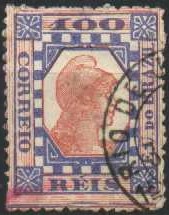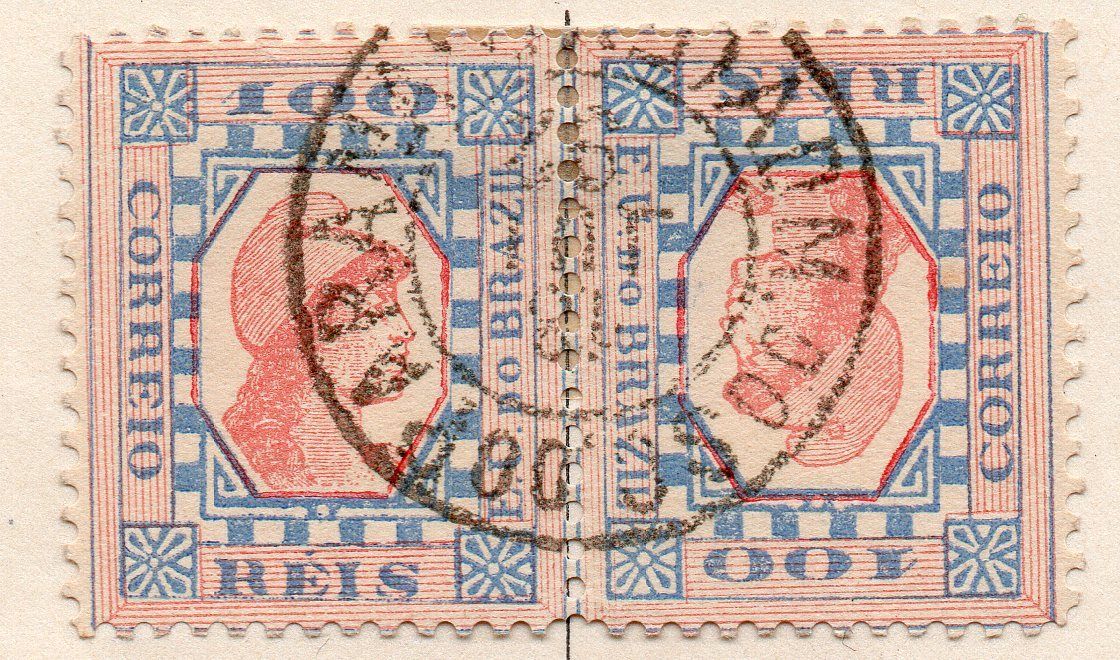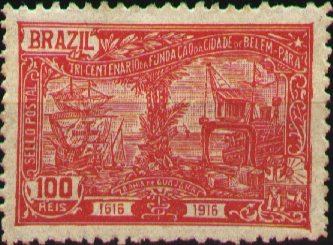 |
|||||
|
|||||
| Preview of Stamps Catalogue: VOLUME 2 |
 |
|||||
|
|||||
| Preview of Stamps Catalogue: VOLUME 2 |
Return To Catalogue - 1843-1865 issues - 1866-1890 issues
Note: on my website many of the
pictures can not be seen! They are of course present in the catalogue;
contact me if you want to purchase it.
For stamps of Brazil issued from 1866 to 1890, click here.

100 r blue and red
Value of the stamps |
|||
vc = very common c = common * = not so common ** = uncommon |
*** = very uncommon R = rare RR = very rare RRR = extremely rare |
||
| Value | Unused | Used | Remarks |
| 100 r | *** | c | Exists with inverted center: RR |

Probably genuine inverted center.
I know that the forger Mercier made a facsimile
with two imperforate tete-beche stamps.
The forger Fournier made forgeries of the inverted center
variety. The cancel "ITAJARY 23 ABR 1891 (S.CATHA)" was
used on these Fournier forgeries. I've also seen the cancel
"ADM DO SC. DO PARANA (EXP.) 18 JUL 92" on a pair of
tete-beche forgeries made by Fournier.


"ITAJARY 23 ABR 1891 (S.CATHA)" cancel, wrongly listed
under Uganda in the 'Fournier Album of Philatelic
Forgeries". Next to it a "ADM DO SC. DO PARANA (EXP.)
18 JUL 92" forged Fournier cancel.



Fournier forgery with the "ITAJARY 23 ABR 1894 S.CATHA"
cancel. Next to it some other Fournier forgeries, they appear to
have the Parana cancel as shown above.

This stamp with inverted center is a forgery! Cut out and then
pasted back center part. The cancel doesn't 'fit' anymore.
The genuine inverted stamps don't have a red box over the blue upper right corner box. The forged ones have.


Genuine left, forged right, images obtained from Bill Claghorn's
forgery site
http://members.tripod.com/claghorn1p/Brazil/Brz109A.htm.


10 r blue 20 r green 100 r lilac
Value of the stamps |
|||
vc = very common c = common * = not so common ** = uncommon |
*** = very uncommon R = rare RR = very rare RRR = extremely rare |
||
| Value | Unused | Used | Remarks |
| 10 r | *** | ** | |
| 20 r | *** | *** | |
| 100 r | *** | *** | |
Overprinted in black or blue (1898)

'200 1898' on 100 r lilac
Value of the stamps |
|||
vc = very common c = common * = not so common ** = uncommon |
*** = very uncommon R = rare RR = very rare RRR = extremely rare |
||
| Value | Unused | Used | Remarks |
| 200 r on 100 r | *** | *** | With black overprint: R |
10 r blue 20 r green 50 r green
Value of the stamps |
|||
vc = very common c = common * = not so common ** = uncommon |
*** = very uncommon R = rare RR = very rare RRR = extremely rare |
||
| Value | Unused | Used | Remarks |
| 10 r | * | c | |
| 20 r | * | * | |
| 50 r | *** | *** | |
Overprinted '1898' and value


20 r on 10 r blue 50 r (blue) on 20 r green 100 r (red or blue) on 50 r green
Value of the stamps |
|||
vc = very common c = common * = not so common ** = uncommon |
*** = very uncommon R = rare RR = very rare RRR = extremely rare |
||
| Value | Unused | Used | Remarks |
| 20 r on 10 r | ** | ** | |
| 50 r on 20 r | ** | * | |
| 100 r on 50 r | *** | *** | With blue overprint: RR |
I've seen imperforate stamps, these could be forgeries.

100 r red
Value of the stamps |
|||
vc = very common c = common * = not so common ** = uncommon |
*** = very uncommon R = rare RR = very rare RRR = extremely rare |
||
| Value | Unused | Used | Remarks |
| 100 r | *** | c | |
Mountain with star (bai of Rio de Janeiro)
10 r (DEZ REIS) red and blue 10 r (REIS 10 REIS) red and blue 20 r orange and blue 50 r blue 50 r green (1900)
These stamps exist with various perforations and also printed on watermarked paper (1905).
Value of the stamps |
|||
vc = very common c = common * = not so common ** = uncommon |
*** = very uncommon R = rare RR = very rare RRR = extremely rare |
||
| Value | Unused | Used | Remarks |
| 10 r | * | c | DEZ REIS |
| 10 r | * | c | REIS 10 REIS |
| 20 r | * | c | |
| 50 r blue | * | c | |
| 50 r green | * | c | |
Head of freedom facing the right
100 r red and black 100 r red (1900) 200 r orange and black 200 r blue (1900) 300 r green and black 500 r blue and black 700 r violet and black
These stamps exist with various perforations and also printed on watermarked paper (1905). Postal forgeries exist of the values 300 r and 500 r (if anybody possesses pictures or information, please contact me!).
Value of the stamps |
|||
vc = very common c = common * = not so common ** = uncommon |
*** = very uncommon R = rare RR = very rare RRR = extremely rare |
||
| Value | Unused | Used | Remarks |
| 100 r red and black | ** | c | Two types; head slightly different |
| 100 r red | *** | c | |
| 200 r orange and black | ** | c | |
| 200 r blue | *** | c | |
| 300 r | *** | c | |
| 500 r | *** | c | |
| 700 r | *** | * | |
Head of Mercury

1000 r green and lilac 2000 r grey and violet
These stamps exist with various perforations and also printed on watermarked paper (1905).
Value of the stamps |
|||
vc = very common c = common * = not so common ** = uncommon |
*** = very uncommon R = rare RR = very rare RRR = extremely rare |
||
| Value | Unused | Used | Remarks |
| 1000 r | *** | * | |
| 2000 r | R | *** | |
Postal forgeries exist, example: a postal forgery of the 500 r value:
The above postal forgery has the 'S' of 'REIS' different (at both sides). Also compare the lines at both sides of the word 'CORREIO'. The 'C' in 'CORREIO' is also different as well as the wreath with leaves. I've also seen the 200 r blue and 300 r of this particular postal forgery.

100 r red 200 r blue and yellow 500 r blue 700 r green
Value of the stamps |
|||
vc = very common c = common * = not so common ** = uncommon |
*** = very uncommon R = rare RR = very rare RRR = extremely rare |
||
| Value | Unused | Used | Remarks |
| 100 r | *** | *** | |
| 200 r | *** | *** | |
| 500 r | *** | *** | |
| 700 r | *** | *** | |

100 r red 200 r blue
Value of the stamps |
|||
vc = very common c = common * = not so common ** = uncommon |
*** = very uncommon R = rare RR = very rare RRR = extremely rare |
||
| Value | Unused | Used | Remarks |
| 100 r | *** | *** | |
| 200 r | *** | ** | |
10 r black (Aristides Lobo) 20 r violet (Benjamin Consant, 2 shades) 50 r green (Alvares Cabral, 2 shades) 100 r red 200 r blue (2 shades) 300 r brown 400 r olive (Prudente) 500 r violet (2 shades) 600 r olive (design identical to 400 r, 2 shades) 700 r brown 1000 r red (woman's head) 1000 r green (1913) 1000 r grey (design as 1000 r green, 1915) 2000 r green (woman's head) 2000 r blue (design as 2000 r green, 1915) 5000 r red (woman's head) 5000 r brown (1917) 10000 r brown
Value of the stamps |
|||
vc = very common c = common * = not so common ** = uncommon |
*** = very uncommon R = rare RR = very rare RRR = extremely rare |
||
| Value | Unused | Used | Remarks |
| 10 r | c | vc | |
| 20 r | c | vc | |
| 50 r | * | vc | |
| 100 r | * | vc | |
| 200 r | * | vc | |
| 300 r | ** | vc | |
| 400 r | ** | * | |
| 500 r | *** | c | |
| 600 r | *** | * | |
| 700 r | *** | * | |
| 1000 r red | R | * | |
| 1000 r green | *** | * | |
| 1000 r grey | *** | * | |
| 2000 r green | *** | * | |
| 5000 r red | R | *** | |
| 5000 r brown | RR | *** | |
| 10000 r | R | *** | |
Vertically imperforated 100 r and 200 r stamps are stamps from stamp booklets issued in 1922, example:

200 r with imperforated vertically
100 r red
Value of the stamps |
|||
vc = very common c = common * = not so common ** = uncommon |
*** = very uncommon R = rare RR = very rare RRR = extremely rare |
||
| Value | Unused | Used | Remarks |
| 100 r | ** | * | |

100 r red
Value of the stamps |
|||
vc = very common c = common * = not so common ** = uncommon |
*** = very uncommon R = rare RR = very rare RRR = extremely rare |
||
| Value | Unused | Used | Remarks |
| 100 r | ** | * | |
200 r blue
Value of the stamps |
|||
vc = very common c = common * = not so common ** = uncommon |
*** = very uncommon R = rare RR = very rare RRR = extremely rare |
||
| Value | Unused | Used | Remarks |
| 200 r | * | * | |

100 r green on yellow
Value of the stamps |
|||
vc = very common c = common * = not so common ** = uncommon |
*** = very uncommon R = rare RR = very rare RRR = extremely rare |
||
| Value | Unused | Used | Remarks |
| 100 r | * | * | |

100 r red
Value of the stamps |
|||
vc = very common c = common * = not so common ** = uncommon |
*** = very uncommon R = rare RR = very rare RRR = extremely rare |
||
| Value | Unused | Used | Remarks |
| 100 r | * | * | |

Apparently a forgery of this stamp.

Similar stamp in the value 300 Rs?

100 r blue
Value of the stamps |
|||
vc = very common c = common * = not so common ** = uncommon |
*** = very uncommon R = rare RR = very rare RRR = extremely rare |
||
| Value | Unused | Used | Remarks |
| 100 r | *** | *** | |

Head to the right 10 r brown 20 r violet 25 r olive 50 r green Head to the left 100 r red 200 r blue 300 r orange 500 r lilac 600 r orange
1000 r blue 2000 r brown 2000 r violet (1920) 5000 r grey 5000 r brown (1920) 10000 r lilac (1928)




10 r lilac 20 r olive 25 r lilac 40 r brown (1922) 50 r blue 50 r brown (1922) 80 r blue (1922) 100 r red 100 r orange (1922) 150 r violet 200 r blue 200 r red (1922) 300 r olive 400 r blue 500 r red 600 r orange 1000 r red
In 1928/29 more values were issued in other colours and values. Example:

(Reduced size)

100 r red
100 r blue 200 r red 300 r green
200 r red
200 r black, blue, yellow and red